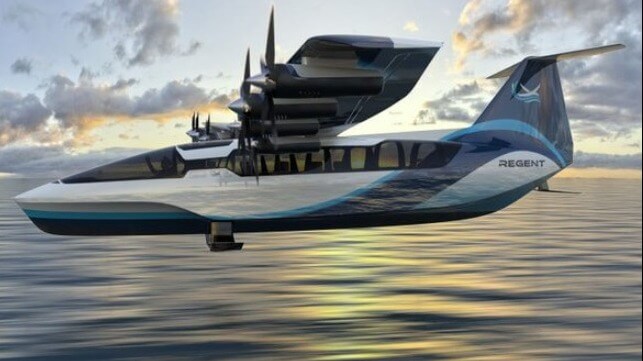Futuristic WIG Sea-Skimming Ferries Complete AiP with BV

The wing-in-ground effect (WIG) seaglider, which has drawn attention both for the maritime and aviation sector, moved a step closer to commercialization with receipt of an Approval in Principle (AiP) from Bureau Veritas Marine & Offshore. A Boston-based startup founded by former employees of Boeing's rapid-prototyping division, Regent (Regional Electric Ground Effect Naval Transport) is developing the concept for the high-wing, hydrofoiling, all-electric plane, that combines designs of airplanes and hydrofoils and is regulated as a ship.
The issuing of the AiP is the culmination of a 10-month long engagement between Regent and Bureau Veritas engineers, which included a series of workshops encompassing aspects of the vehicle’s structure, mechanical systems, avionics, propulsion, and safety systems. Throughout the process, Bureau Veritas provided preliminary expert advice with a focus on the early identification of rules and regulatory framing for the seaglider’s classification.
“This certification milestone is an extremely important moment for the seaglider’s design and technical maturity,” said Billy Thalheimer, co-founder and CEO of Regent. “It is the first major outcome of our maritime certification process. The Approval in Principle confirms we are on an achievable certification path towards the commercialization of seagliders.”
The review was completed for Regent’s 12-passenger, fully electric design known as the Viceroy. The company explains that the vessels will operate a few meters off the water's surface and couple the high speed of aircraft with the low operating cost of vessels. With the existing battery technology, Regent said last fall that it was already possible to service routes of approximately 180 miles at speeds up to 160 knots. They believe future battery technology will make it possible to operate at ranges over 400 miles. Advancements in battery technology will also permit the company to increase the size of the vessel with the next generation envisioned as a design for 50 passengers and longer term to 150 or more people.
Since announcing its concept, Regent has attracted strong interest including from Brittany Ferries which last year Brittany Ferries signed a letter of intent with Regent that could see them develop seagliders with a 50-150 passenger capacity that could be sailing between the UK and France by 2028. A U.S. regional airline, Mesa Group, has said it is exploring the purchase of 200 of the new WIG craft to build out a city-to-city network.
Regent reports that the AiP will be followed by a design appraisal process, including a series of technical studies that are now underway that will allow the implementation of the seaglider’s design and operation without significant risk of compliance or qualification issues. In conducting a Design Appraisal, Bureau Veritas Marine & Offshore will provide an independent, safety-based certification of Regent’s seaglider design.
The company also plans to leverage the AiP in support of a Design Basis Agreement with the U.S. Coast Guard, which is expected this fall. The AiP and DBA form a classification and certification basis with both Bureau Veritas and the U.S. Coast Guard, similar to the G-1 and G-2 issue papers used in FAA aircraft certification.
Regent has forecast that the vessels could be in commercial operations before the end of the decade. They report a backlog of $7 billion in provisional orders for their seagliders from ferry and aviation operators.
